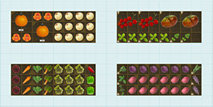Basics
- Ease of Growing
- Easy
- Grown as
- Perennial
- Growing Habit
- -
- Hardiness
- Half Hardy
- Crops
- Spring Transplant, Spring
- Growing Season
- Short, Long
- Cultivar Type
- -
- Growing Conditions
- Cool, Warm
They grow best in the mild, damp, maritime climate of coastal California. The plants won't survive in cold winters, so in Northern areas they must either be grown as annuals or protected over the winter. They need full sun.
- Outdoor Growing Temp
- 45°F - 85°F
- Min Outdoor Soil Temp
- 55°F
Don’t plant out until all frost danger is past and the soil has warmed up to at least 55˚ F.
- Start Indoors
- Yes
- Start Outdoors
- Yes
- Light
- Sun: min. 6 hours daily (Cool, Warm)
Cardoons are native to the Mediterranean and need full sun for best growth, although they do not mind fog.
- Water
- Moderate
Though relatively drought tolerant, Cardoons yield better if the soil is kept evenly moist.
- Feeder
- Light
Cardoons are most productive when grown without any check in their growth, which means they must get all the nutrients they need. They are usually fed annually with a mulch of compost or aged manure. You can also use an occasional foliar feed of compost tea or liquid kelp.
- Suitability
- Needs lots of space
- Small Gardens?
- No
- Containers?
- Yes, but will need a large one, like a half wine barrel
Cardoons can be grown in containers, but it's tricky and requires a lot of work. It's important to choose a pot with the right dimensions. Your container needs to be at least 20" deep and 36 to 40" in diameter. Choose a pot that has several drain holes on the bottom, as artichokes are very susceptible to being waterlogged. Line the bottom with large stones/gravel or netting to prevent soil erosion and fill with a light and loamy, moisture-retaining soil. Incorporate fertilizer such as compost or manure a few days before you plant your cardoons. They require lots of water and nutrients. Water well 3 to 4 times a day, and fertilize regularly with compost tea every 1 or 2 weeks. It can also be helpful to use a high-nitrogen fertilizer for the first 3 to 4 weeks. Make sure your plants receive plenty of sunshine.
- Attracts beneficial insects?
- Yes
- Color
- -
- Fruit Size
- - "
- Plant Height
- 24.0 - 48.0"
- Plant Diameter
- 18.0 - 36.0"
- Good Companions
- -
- Bad Companions
- -
- Hardiness Zone
- 7-10
- Disease Resistance
- -
- Taste Profile
Rich flavored stalks. The leaves are bitter.
- Rotation Group
- Perennial

